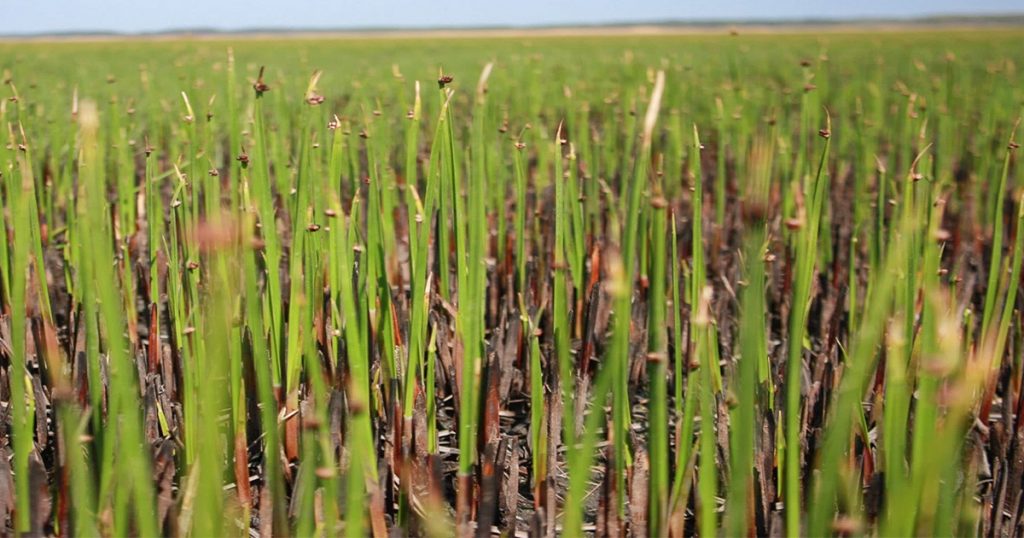Tall marsh sedges and grasses sway in the coastal winds along the shoreline and the islands throughout the Chesapeake Bay. These plants root into the soil along the water’s edge, offering coastal protection against the rhythmic beating of the waves.
This scenic ecosystem might not seem like a place where artificial intelligence and deep learning methods would also take root. A collaboration between computer science and biology researchers at UT found calculations about the marshes, however, that help reveal how ecologically important plants have adapted to the changing climate.
EECS Associate Professor Scott Emrich contributed from the computer-science angle for research published early in 2023 in the journal Science. He worked with a team co-led by Professor Michael Blum in UT’s Department of Ecology and Evolutionary Biology. Blum has investigated changes in plant life for 20 years, and this study presented details that revealed ecosystem-scale effects of rapid evolution. Their research revealed elements of plant evolution that must be accounted for to understand how global change affects these coastal wetlands.
“There’s a sedge called Schoenoplectus americanus, and its common name is Chairmakers Bulrush,” said Emrich. “It grows in the Smithsonian Chesapeake Bay Preserve, and the seeds get deposited in the seedbank. So, what you can do is go to the preserve, dig down, take a core of the soil, and you can roughly date when the seed’s parents were alive. If you’re a foot down, the seeds roughly correspond to plants alive in 1900, give or take.”
This kind of resurrection ecology offers an environmental time machine that allows for genetic comparisons between historic seeds and contemporary ones, and to observe functional differences in the full plants grown from seeds of different eras.
These test plants were grown in the UT greenhouse by Blum, who worked with other team members to conduct a field scale common garden experiment at the Smithsonian Environmental Research Center research site in the Chesapeake. Then, multiple factors went into a mathematic summation of the sedge’s responses to environmental pressures like CO2 levels over time, as well as plant genetics, and their origin location around the Chesapeake Bay area.
“There were two separate calculations,” said Emrich. “One, modeling CO2 and sea levels over time—this was work done by Kathe Todd-Brown, assistant professor and computational biogeochemist at the University of Florida. Two, showing that the plants grown in the greenhouse from different time periods were ‘typical’ members of the species, i.e., the genetic diversity used in the greenhouse was similar to the genetic diversity across the entire sample site.”
Emrich and team used a population genetics/mathematical technique called Principal Components Analysis (PCA) to do the latter calculations, along with more complicated ancestry analysis to determine how distinct the genetic lineages are and how they have mixed in the Chesapeake over time.
“This required extracting the genetic information from hundreds of plants, determining a way to create a ‘reference,’ since there is no available complete genome sequence for the sedge, and then running bioinformatics software to find where each plant differed, or not, from the reference, and how the plants across the Chesapeake are related, if at all,” said Emrich.
The results from their analysis show which sites have the most genetically mixed grasses, which are the most isolated and different from the rest, and—importantly—that samples grown and used in field experiments are not genetically different from the big picture of the bay.
“Our study shows how important it can be to account for rapid evolution in models designed to forecast the fate of high-value ecosystems like coastal marshes,” said Blum. “Further efforts to understand how coastal marsh plants may respond to future climate change can lead to better management of services like storm protection, removing carbon dioxide from the atmosphere, and fisheries production.”
Emrich is already engaged in other cross-disciplinary collaborations like this one.
“Using the same pipeline, we trained two underrepresented students in computer science for a USDA funded Research Experience for Undergraduates program I am involved in,” he said. “These students were able to look at the genetic diversity of an important mosquito disease vector in the western US and show how its population is affected by historical temperature and rainfall data. Also, we are working on a manuscript with Andrew Steen and Karen Lloyd (UT microbiology department) trying to use similar methods to uncover genes that are predictive of certain microbiology traits.”
These seeds of collaboration offer the potential for discovery far beyond the shores of the Chesapeake Bay.
Contact
Randall Brown (865-974-0533, rbrown73@utk.edu)
